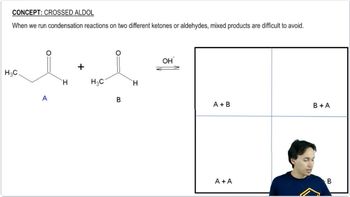Here are the essential concepts you must grasp in order to answer the question correctly.
Aldol Addition
Aldol addition is a reaction between two carbonyl compounds, typically aldehydes or ketones, that results in the formation of a β-hydroxy carbonyl compound. This reaction involves the nucleophilic attack of an enolate ion on another carbonyl carbon, leading to the formation of a new carbon-carbon bond. The aldol product can further undergo dehydration to yield an α,β-unsaturated carbonyl compound.
Recommended video:
Acid Catalysis
Acid catalysis involves the use of an acid to increase the rate of a chemical reaction. In the context of aldol addition, the acid protonates the carbonyl oxygen, enhancing the electrophilicity of the carbonyl carbon. This makes it more susceptible to nucleophilic attack by the enolate ion, facilitating the formation of the aldol product.
Recommended video:
Acid-Base Catalysis Concept 3
Mechanism of Aldol Addition
The mechanism of acid-catalyzed aldol addition begins with the protonation of the carbonyl oxygen, followed by the formation of an enol or enolate ion from another molecule of the aldehyde. The enolate then attacks the protonated carbonyl carbon, leading to the formation of the β-hydroxy carbonyl compound. This mechanism highlights the role of acid in stabilizing intermediates and promoting the reaction pathway.
Recommended video:
 Verified step by step guidance
Verified step by step guidance Verified video answer for a similar problem:
Verified video answer for a similar problem:

